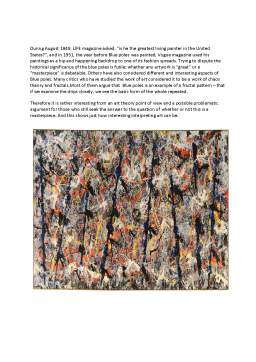Extras din referat
About Jackson Pollock
He was widely noticed for his technique of pouring or splashing liquid household paint onto a horizontal surface (‘drip technique’), enabling him to view and paint his canvases from all angles. It was also called ‘action painting’, since he used the force of his whole body to paint, often in a frenetic dancing style. This extreme form of abstraction divided the critics: some praised the immediacy and fluency of the creation, while others derided the random effects. In 2016, Pollock's painting titled Number 17A was reported to have fetched US$200 million in a private purchase. A reclusive and volatile personality, Pollock struggled with alcoholism for most of his life. In 1945, he married the artist Lee Krasner, who became an important influence on his career and on his legacy. Pollock died at the age of 44 in an alcohol-related single-car accident when he was driving. In December 1956, four months after his death, Pollock was given a memorial retrospective exhibition at the Museum of Modern Art (MoMA) in New York City. A larger, more comprehensive exhibition of his work was held there in 1967. In 1998 and 1999, his work was honored with large-scale retrospective exhibitions at MoMA and at The Tate in London.
About Blue poles
Blue Poles, also known as Number 11, 1952 is an abstract expressionist painting and one of the most famous works by American artist Jackson Pollock. It was purchased amid controversy by the National Gallery of Australia in 1973 and today remains one of the gallery's major paintings. According to art historian Dennis Phillips, the specific rather than ambiguous title "limits our field of comprehension and does the painting a singular disservice. Because we look for the poles and miss much of the rest, the name is simply too distracting."
Look: What lays before your eyes? It’s a big painting, with splashes of color just splashed on the canvas, randomly or applied carefully with a calibrated brush? This particular painting from Jackson Pollock falls and has been thrown by critics in between these two extremes. The abundance of color strikes you, first noticing the lines of light blue paint, red, green and also some silver accents. Upon a closer inspection of the painting there is a bare footprint visible on the top right and at the other end of the spectrum there are eight highly-prominent darker blue pole-like lines down the canvas, at different angles to each other.
See: Let us now interpret what we see in front of us, while unpacking the symbols we recognize, and of course I am now referring to the iconography. The blue poles are completely abstract together with the footprint and the rest is just wild, crazy shapeless splats that don’t represent anything, at first glance
Think: This step is where you, the viewer, have to plug in your brain and do some work. Don’t think of looking at art as like watching the TV. It’s more like doing a crossword puzzle or Sudoku - it is work, but it’s fun.
Let’s now interpret all those clues in a creative manner. Interpretation, of course, doesn’t mean that any explanation is right regardless of how wacky. It means you have to consider what is plausible. We have to consider what was happening in the world in which the work came about, and in the artist’s life, to find the clues. The first thing to ask is: who is the artist? What do we know about them? In this case, even if it’s just “Jackson Pollock was a drunk”, we have something to work from.
Skim-reading Wikipedia, we can see he was an “Abstract Expressionist”, he painted canvases flat on the floor, and he was a reclusive who underwent psychoanalysis to treat his alcoholism. Now you’ve got some context. So, let’s put it all together.
Preview document
Conținut arhivă zip
- Blue Poles.docx




